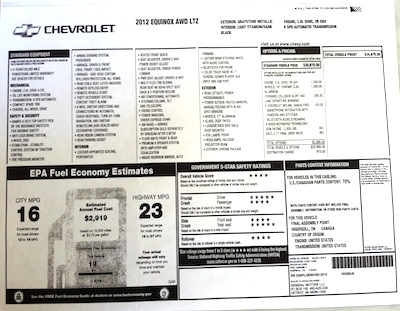Help! The Car Window Sticker is So Confusing; This is What You Need To Know

This little wall of information is your truth-telling friend at a car dealership.
Not that we don’t love our friends at car dealerships, but cars have a LOT of details. As in, thousands of tiny yet very important details. Like, does it have adaptive cruise control? Brake hold? Apple CarPlay? Android Auto? Or both? It can be easy to get confused when comparing trims, much less competitors. So grab a copy of the car window sticker, formally known as a Monroney. Sit and study a bit. That’s how you’ll know just what you’re getting for your money.
Information Is Power In Your Hands
Don’t let the car window sticker intimidate you. Believe it or not, the information is there for your protection. The Monroney was created as a result of the 1958 Automobile Information Disclosure Act. It is named after Mike Monroney, the US Senator from Oklahoma who authored the law. It’s sort of like that tag on a new mattress with the bold declaration that it can only be removed by the buyer. Same with the Monroney. It’s there for your information, and dealers cannot remove it from a new car.
The Monroney has a lot of things you may not care much about, like where they built the car or sourced its parts. However, the Monroney has items you should look at to understand what you are buying:
Standard Equipment
What is included in the base price of this car? Manufacturers have some flexibility in what they list on the sticker. For instance, some will list the car’s horsepower, while others won’t.
Look at interior features, safety features, technology, engine specs, exterior features, and warranty information. Make note of any particular features on the sticker that you are looking for, like all-wheel drive or the fuel octane rating the car requires. If not listed, be sure to ask!
Optional Equipment
This will follow standard equipment. What things were added to this car that are not part of the base price? And do you really want all these things?
Manufacturer’s Suggested Retail Price
This is often a tiny number buried someplace on the page. Oftentimes, it has its own column near the end of the standard equipment listing. This is the base price of this particular car (which may vary from the base price of other similar models). However, it does not include taxes and registration fees.
Destination Charge
The manufacturer charges a fee to deliver the car to the dealership. In turn, the dealership passes this on to the buyer.
Total Price
The total price of the vehicle will include the price of optional equipment and destination charges. Typically, you can find the total price somewhere near the end of the list on the Monroney.
Fuel Economy and Emissions Estimates
The Monroney should prominently display the fuel economy and emissions estimate. This will let you know the approximate gas mileage you’ll get and how much carbon the car will release into the atmosphere. Law requires automakers to include these estimates. They often also include an annual fuel cost estimate. While this is helpful for considering your overall budget for the vehicle and fuel, it isn’t a perfect estimate. Of course, we’ve all seen the severe fluctuation of gas prices. Additionally, driving style, type of tires, terrain and more can have a big impact on fuel economy.
Government Safety Ratings
If the model you are looking at has been safety tested, the Monroney will list its safety ratings. However, most new cars have not gone through safety testing before they print the stickers. Luckily, most meet or exceed government safety regulations anyway. For both of those reasons, this field is usually blank.
Keep In Mind: Not All Monroneys Are The Same
Manufacturers often use their own lingo or trademarked names to describe features. Also, Monroneys don’t mention every feature. They only include the most important ones. Additionally, the law requires automakers to disclose certain information on the Monroney. So, take note of the features you’re most interested in, and make sure that the car you’re considering has them.
Ask for a copy of the Monroney to take with you after you test drive the car. You can also use your phone to snap a photo of the window sticker on the car. That way you’ll have the exact product details on hand for comparison to other brands and models.
You can even get a copy of the Monroney for a used car; the dealer may have it, third party services like CarFax often provide them, or they can be purchased on line. This is great because it can be hard to tell what equipment was part of a car built several years ago.
If you want to have a little fun, see if the salespeople you’re working with can explain everything listed on the Monroney. Our guess is they can’t!

